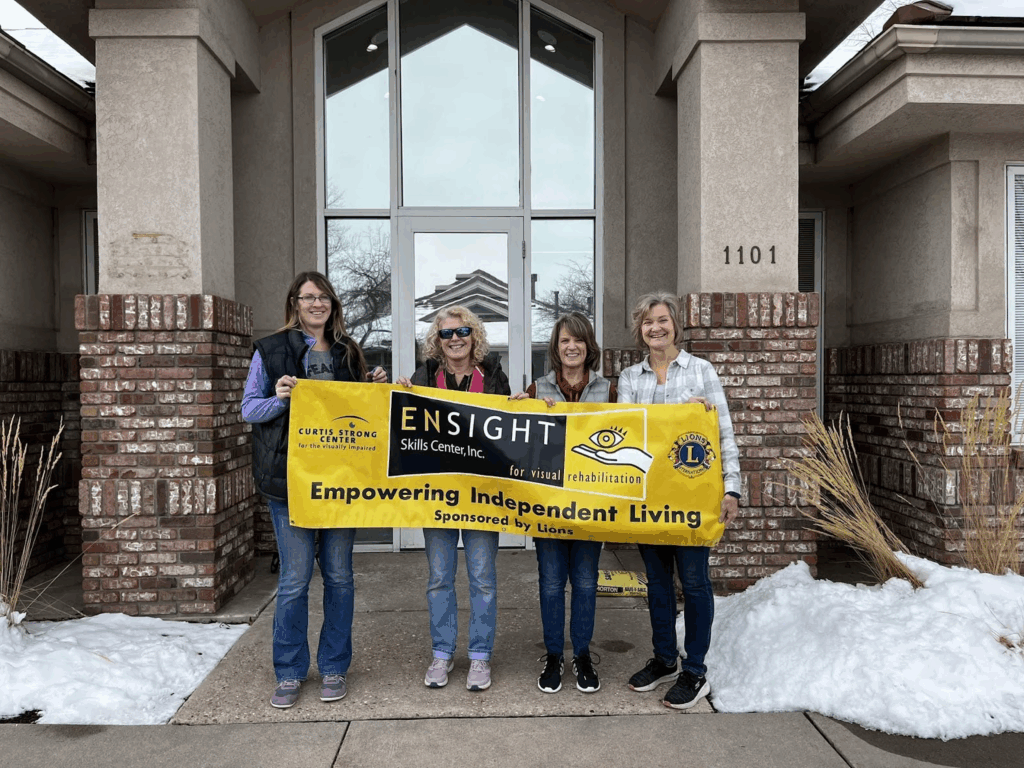Vision loss can happen gradually, making it difficult to recognize when someone you care about might benefit from low vision services. Unlike complete blindness, low vision means having some remaining sight that cannot be fully corrected with glasses, contact lenses, or medical treatment. Recognizing the early signs can help your loved one maintain their independence and quality of life through specialized training and adaptive techniques.
Understanding Low Vision
Low vision affects people differently depending on their specific condition. Some individuals may experience difficulty with central vision, which can make it challenging to see details directly in front of them. Others may struggle with peripheral vision, which can create challenges with mobility and spatial awareness. Some experience problems with contrast or light sensitivity. Understanding these variations helps explain why the signs can be subtle and varied.
>Alt text< A pair of eyeglasses with clear plastic frames is being held up in front of an eye chart, showing the letters and numbers in sharp focus through the lenses, while the background chart appears blurred.
Daily Living Challenges
One of the most telling indicators that someone may benefit from low vision services is difficulty with everyday activities they previously managed with ease. You may notice that your loved one is struggling to read mail, newspapers, or medication labels, even with their regular glasses. They may hold reading materials unusually close or far away, or require significantly more light than before.
Kitchen activities often become challenging. Your loved one might have trouble seeing expiration dates, distinguishing between similar-looking containers, or safely using the stove. They may begin avoiding cooking altogether or expressing frustration with tasks that were once routine. Similarly, managing medications can become problematic, with difficulty reading prescription labels or distinguishing between different pills.
Social and Emotional Changes
Vision changes often lead to behavioral shifts that family members notice before the person experiencing them fully acknowledges the problem. Your loved one might begin declining social invitations, especially for evening events or activities in unfamiliar locations. They may show reluctance to drive, particularly at night or in challenging conditions like rain or bright sunlight.
You might observe increased anxiety or frustration during activities that require visual attention. Some people become withdrawn or depressed as they struggle with tasks they can no longer perform confidently. Others may become more dependent on family members for assistance with activities they previously handled independently.
Mobility and Safety Concerns
Changes in how someone moves through their environment can signal vision problems. Your loved one might walk more slowly or cautiously, especially on stairs or uneven surfaces. They may begin using handrails more frequently or appear uncertain when navigating familiar spaces. Bumping into furniture, door frames, or other objects more frequently than usual is another concerning sign.
Driving behaviors often change as well. You might notice your loved one avoiding highways, unfamiliar routes, or driving during certain times of day. They may sit closer to the steering wheel, squint frequently while driving, or seem to have more difficulty judging distances when parking or merging.
Technology and Entertainment Struggles
Modern life requires significant visual interaction with technology, and difficulties in this area can be particularly telling. Your loved one might struggle to see their smartphone screen clearly, have trouble with computer displays, or find television viewing less enjoyable. They may frequently ask others to help with technology tasks they previously managed independently.
Reading for pleasure, completing puzzles, or engaging in hobbies that require detailed vision may become frustrating or impossible. You might notice craft projects abandoned, books left unfinished, or a general loss of interest in visually demanding activities.

When to Seek Low Vision Services
If you recognize several of these signs in your loved one, it may be time to explore low vision services. These specialized programs don’t require a referral and can be incredibly beneficial even for people who are still managing some daily activities independently. The goal isn’t to wait until someone can no longer function, but rather to provide tools and training that help maintain independence and confidence.
Low vision services typically include comprehensive assessments to determine which adaptive techniques and devices might be most helpful. This could include training with magnification devices, improved lighting solutions, high-contrast materials, or technology adaptations. Professionals also teach practical techniques for safely performing daily activities and maintaining independence.
How to Approach the Conversation
Discussing potential vision problems with a loved one requires sensitivity and patience. Many people are reluctant to acknowledge vision changes due to fear of losing independence or facing difficult lifestyle changes. Focus on specific observations rather than general statements about their vision. For example, mention that you’ve noticed they seem to need more light for reading rather than saying their eyesight is getting worse.
Emphasize that low vision services are designed to help people maintain their independence and continue enjoying activities they value. Share success stories of others who have benefited from these services, and offer to accompany them to an initial consultation if that would provide comfort.
Taking Action
Early intervention with low vision services often leads to better outcomes and greater success with adaptive techniques. If your loved one is experiencing vision changes, encourage them to speak with their eye care professional about low vision evaluation and services. Many people are surprised to learn how much specialized training and adaptive devices can improve their daily functioning and quality of life.
Remember that vision loss doesn’t mean loss of independence. With the right support and training, people with low vision continue to live fulfilling, active lives. Recognizing the signs early and connecting your loved one with appropriate services is one of the most valuable gifts you can provide.
At Ensight Skills Center, we understand that each person’s vision challenges are unique, and we’re committed to providing personalized training and support that helps individuals maintain their independence and pursue their goals. If you recognize these signs in someone you care about, we encourage you to reach out and learn more about how low vision services can make a meaningful difference in their life.
Ready to learn more? Visit our main resource page for detailed information about our services, upcoming programs, and how to get started on your path to greater independence and well-being.

Contact Curtis Strong and Ensight Skills Centers today to discover how we can help you or your loved one navigate life with vision loss more confidently and independently.

For more information on this topic, watch our Youtube video! To stay connected and up-to-date with the latest opportunities and success stories, we encourage you to follow Ensight on all of our social media platforms. Visit Ensight Skill Center’s Homepage for a comprehensive overview of our programs, sign up for our Newsletter, and connect with us on Facebook, LinkedIn, and Instagram to gain access to valuable resources, inspiring stories, and updates on all of our upcoming events.
Meta Description:
Learn how to recognize early signs of low vision in your loved ones and discover how specialized low vision services can help them maintain independence, safety, and quality of life. Explore daily living tips, mobility support, and adaptive solutions from Ensight Skills Center.